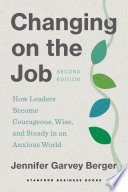Changing on the Job, Second Edition by Jennifer Garvey Berger — Book Review
In a world that seems to demand constant evolution just to keep pace, Jennifer Garvey Berger’s “Changing on the Job, Second Edition” feels like a timely intervention. It’s a book that doesn’t just talk about change but delves into the hows and whys of personal and professional transformation. Imagine a world where our personal growth could match the speed of technological advancement—what would that mean for our workplaces, our relationships, and our own sense of fulfillment? Berger doesn’t just ask these questions; she provides a roadmap for navigating them.
Berger’s writing carries an inviting tone that balances academic rigor with warmth and accessibility. It’s a book that doesn’t leave the reader feeling like they’re trudging through a dense field of jargon. Instead, it invites you to walk alongside the author as she explores complex ideas through storytelling and practical insights. The pacing is deliberate yet engaging, each chapter building upon the last, creating a crescendo of understanding that feels both natural and enlightening. The mood is one of optimism and curiosity, making it a perfect read for leaders, educators, and lifelong learners who are ready to embrace and instigate change.
“Changing on the Job” isn’t just for the traditional business leader. Its reach extends to anyone who finds themselves in a position to influence others—be it in the office, classroom, or at home. It’s particularly resonant for those who are open to introspection and ready to challenge their own mental models. Berger’s audience is those who understand that the world is changing, and that to lead effectively within it, they too must change.
At the heart of “Changing on the Job” is the idea that leadership is a personal journey of growth and development, not just a set of skills to be acquired. Berger introduces the concept of “growth mindset” as a pivotal framework for understanding how adults can develop their capacities to handle complexity. By exploring Robert Kegan’s theory of adult development, she unfolds the layers of how leaders can evolve from simple problem solvers to complex thinkers who thrive in ambiguity.
A particularly striking argument Berger makes is that traditional leadership development often falls short because it focuses on adding competencies rather than transforming mindsets. She suggests that real change happens not when we learn new skills, but when we fundamentally alter the way we see the world and our place in it. This concept is powerful, especially in today’s fast-paced environments where yesterday’s solutions are rarely sufficient for today’s challenges.
The book also dives into practical strategies for fostering this type of growth, both personally and within organizations. Berger talks about the importance of creating environments that encourage experimentation and reflection, enabling leaders to move through the stages of development. Her approach is holistic, considering not just cognitive growth but emotional and relational aspects as well. This is a refreshing departure from the often mechanical approaches of traditional leadership books, offering a more human-centric view of development.
Connecting these ideas to broader themes, the book resonates deeply with the current landscape of work and society. In a time when adaptability is not just an asset but a necessity, Berger’s insights are particularly relevant. With the rise of remote work, digital transformation, and the increasing demand for diversity and inclusion, leaders are faced with unprecedented challenges and opportunities. Reflecting on recent events, such as the pandemic’s impact on workplace dynamics, it’s clear how crucial it is for leaders to develop the capacity for complex thinking and emotional intelligence that Berger advocates.
Furthermore, Berger’s work aligns with other contemporary thought leaders like Carol Dweck, whose research on the growth mindset has revolutionized educational and organizational approaches. By synthesizing these ideas, Berger offers a compelling narrative that bridges the gap between theory and practice.
Personally, reading “Changing on the Job” was a transformative experience. It challenged me to reflect on my own leadership style and the ways in which I might be unconsciously resisting change. The book encouraged me to view challenges not as obstacles but as opportunities for growth—a perspective that has already begun to alter my approach to both personal and professional situations. Berger’s insights into creating developmental cultures have inspired me to advocate for more reflective practices in my own work environments, fostering spaces where growth is not just encouraged but expected.
In conclusion, “Changing on the Job, Second Edition” is an essential read for anyone looking to deepen their understanding of leadership in the 21st century. Jennifer Garvey Berger has crafted a guide that is as intellectually stimulating as it is practical, offering valuable insights for leaders at any stage of their journey. It’s a book that doesn’t just inform but transforms, making it an invaluable resource for those ready to embark on a path of true developmental change. Whether you’re a seasoned executive or an aspiring leader, this book provides the tools and the inspiration to not just change on the job, but to thrive in the ever-evolving landscape of work and life.

Changing on the Job, Second Edition
Author: Jennifer Garvey Berger
Publisher: Stanford University Press
Published: November 12, 2024
Get the book